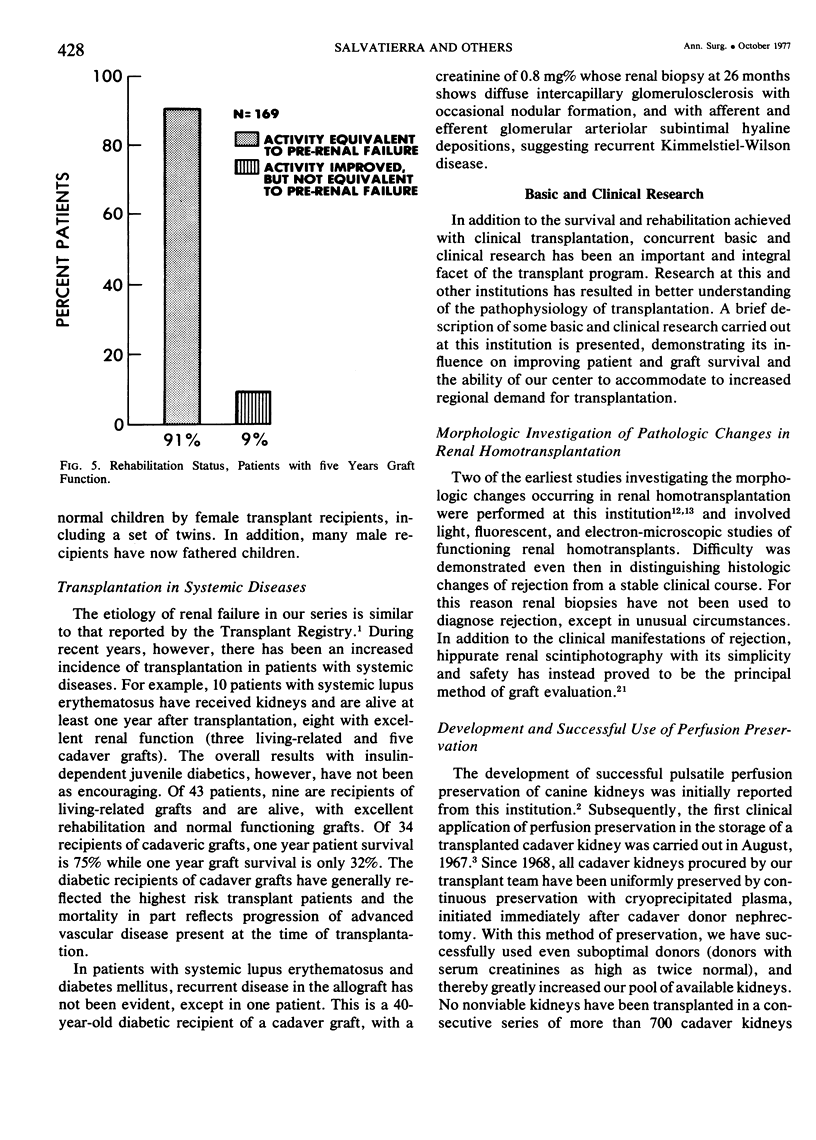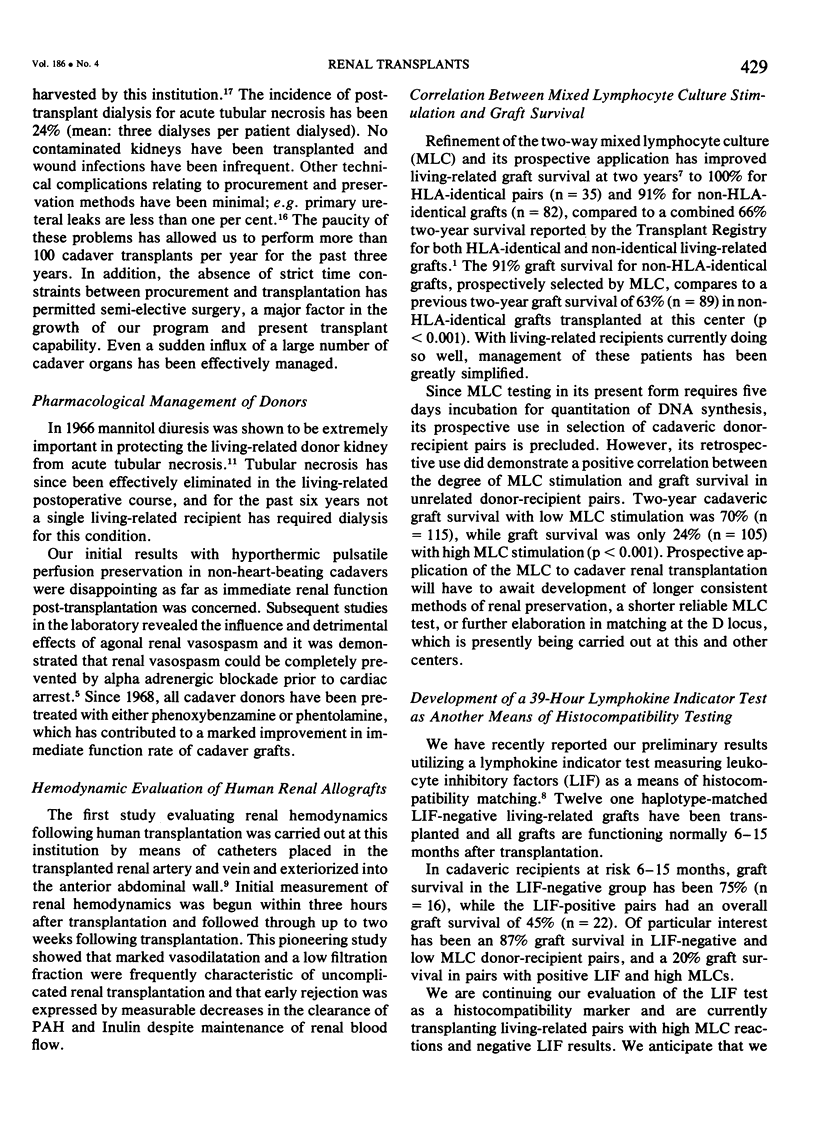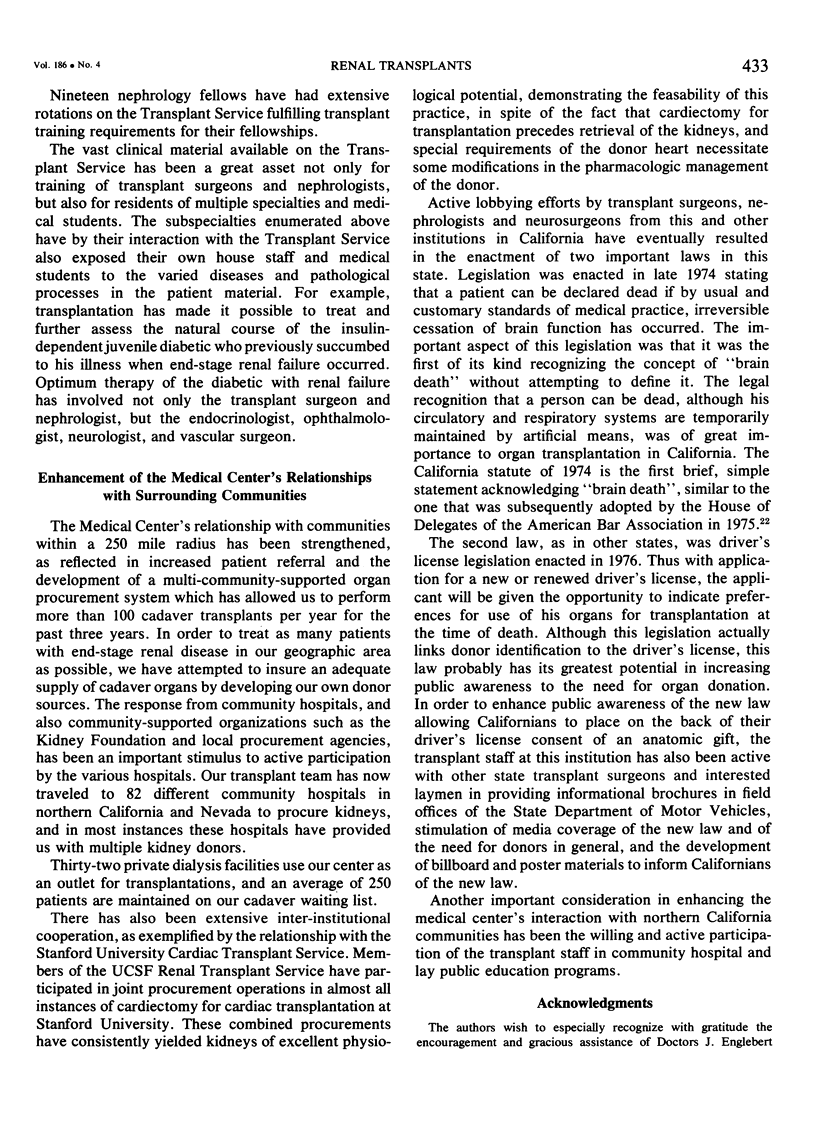Abstract
A large, comprehensive renal transplant program has a major impact not only on patient care, but also on the medical center itself and the larger community. The program at this center has advanced from 15 transplants in 1964 to 141 transplants in 1976. Fifty-nine per cent of patients transplanted have functioning kidneys at this time, including 76 children. Rehabilitation was equal to prerenal disease level in 91% of 169 recipients who lived five years with a functioning graft. Basic research in such diverse areas as renal preservation and immunology, as well as clinical research in optimum immunosuppressive therapy, resulted in significant contributions. Refinement of the mixed lymphocyte culture improved living-related graft survival at two years: 100% for HLA-identical and 91% for non-HLA-identical grafts, compared to 66% reported by the Transplant Registry for the combined group. Modification of immunosuppression improved patient survival at two years: 100% and 86% for recipients of living-related and cadaver grafts, respectively, compared to 83% and 65% reported by the Transplant Registry. The complexity of care of the patient with end-stage renal failure has required active interaction between transplant surgeons and almost every major specialty. The vast clinical material has been a great asset for training transplant surgeons, nephrologists, fellows and residents of multiple specialties, and medical students. The medical center's relationship with communities within a 250 mile radius has been strengthened, as reflected in patient referrals and the development of a multi-community-supported organ procurement system, which has allowed us to perform over 100 cadaver transplants per year for the past three years. Thus the performance of 1,000 renal transplants at this center has resulted not only in rehabilitation of many renal failure patients, but also in expanded and improved research and teaching capabilities, bringing support from multiple medical disciplines and the general community.
Full text
PDF










Selected References
These references are in PubMed. This may not be the complete list of references from this article.
- Belzer F. O., Ashby B. S., Dunphy J. E. 24-hour and 72-hour preservation of canine kidneys. Lancet. 1967 Sep 9;2(7515):536–538. doi: 10.1016/s0140-6736(67)90498-9. [DOI] [PubMed] [Google Scholar]
- Belzer F. O., Ashby B. S., Gulyassy P. F., Powell M. Successful seventeen-hour preservation and transplantation of human-cadaver kidney. N Engl J Med. 1968 Mar 14;278(11):608–610. doi: 10.1056/NEJM196803142781108. [DOI] [PubMed] [Google Scholar]
- Belzer F. O., Perkins H. A., Fortmann J. L., Kountz S. L., Salvatierra O., Cochrum K. C., Payne R. Is HL-A typing of clinical significance in cadaver renal transplantation? Lancet. 1974 Apr 27;1(7861):774–777. doi: 10.1016/s0140-6736(74)92842-6. [DOI] [PubMed] [Google Scholar]
- Belzer F. O., Reed T. W., Pryor J. P., Kountz S. L., Dunphy J. E. Cause of renal injury in kidneys obtained from cadaver donors. Surg Gynecol Obstet. 1970 Mar;130(3):467–477. [PubMed] [Google Scholar]
- Cochrum K. C., Salvatierra O., Belzer F. O. Correlation between MLC stimulation and graft survival in living related and cadaver transplants. Ann Surg. 1974 Oct;180(4):617–622. doi: 10.1097/00000658-197410000-00027. [DOI] [PMC free article] [PubMed] [Google Scholar]
- Cochrum K. C., Salvatierra O., Cullen B. L., Perkins H. A., Hanes D. M., Fudenberg H. H. Leukocyte migration inhibitory factor (LIF) as an indicator of mixed lymphocyte culture (MLC) reactivity. Transplant Proc. 1977 Mar;9(1):97–101. [PubMed] [Google Scholar]
- Kountz S. L., Truex G., Earley L. E., Belzer F. O. Serial hemodynamics after renal allotransplantation in man. Circulation. 1970 Feb;41(2):217–224. doi: 10.1161/01.cir.41.2.217. [DOI] [PubMed] [Google Scholar]
- MERRELL M., SHULMAN L. E. Determination of prognosis in chronic disease, illustrated by systemic lupus erythematosus. J Chronic Dis. 1955 Jan;1(1):12–32. doi: 10.1016/0021-9681(55)90018-7. [DOI] [PubMed] [Google Scholar]
- Najarian J. S., Gulyassy P. P., Stoney R. J., Duffy G., Braunstein P. Protection of the donor kidney during homotransplantation. Ann Surg. 1966 Sep;164(3):398–417. doi: 10.1097/00000658-196609000-00004. [DOI] [PMC free article] [PubMed] [Google Scholar]
- Rosenau W., Lee J. C., Najarian J. S. A light, fluorescence, and electron microscopic study of functioning human renal transplants. Surg Gynecol Obstet. 1969 Jan;128(1):62–76. [PubMed] [Google Scholar]
- Salvatierra O., Jr, Kountz S. L., Belzer F. O. Prevention of ureteral fistula after renal transplantation. J Urol. 1974 Oct;112(4):445–448. doi: 10.1016/s0022-5347(17)59757-8. [DOI] [PubMed] [Google Scholar]
- Salvatierra O., Jr, Olcott C., 4th, Cochrum K. C., Amend W. J., Jr, Feduska W. J., Jr Procurement of cadaver kidneys. Urol Clin North Am. 1976 Oct;3(3):457–473. [PubMed] [Google Scholar]
- Salvatierra O., Jr, Perkins H. A., Amend W., Jr, Feduska N. J., Duca R. M., Potter D. E., Cochrum K. C. The influence of presensitization on graft survival rate. Surgery. 1977 Feb;81(2):146–151. [PubMed] [Google Scholar]
- Salvatierra O., Jr, Perkins H. A., Cochrum K. C., Duca R. M., Potter D. E., Amend W. J., Feduska N. J. HLA typing and primary cadaver graft survival. Transplant Proc. 1977 Mar;9(1):495–501. [PubMed] [Google Scholar]
- Salvatierra O., Jr, Potter D., Cochrum K. C., Amend W. J., Duca R., Sachs B. L., Johnson R. W., Belzer F. O. Improved patient survival in renal transplantation. Surgery. 1976 Feb;79(02):166–171. [PubMed] [Google Scholar]
- Salvatierra O., Jr, Powell M. R., Price D. C., Kountz S. L., Belzer F. O. The advantages of 131I-orthoiodohippurate scintiphotography in the management of patients after renal transplantation. Ann Surg. 1974 Sep;180(3):336–342. doi: 10.1097/00000658-197409000-00014. [DOI] [PMC free article] [PubMed] [Google Scholar]


